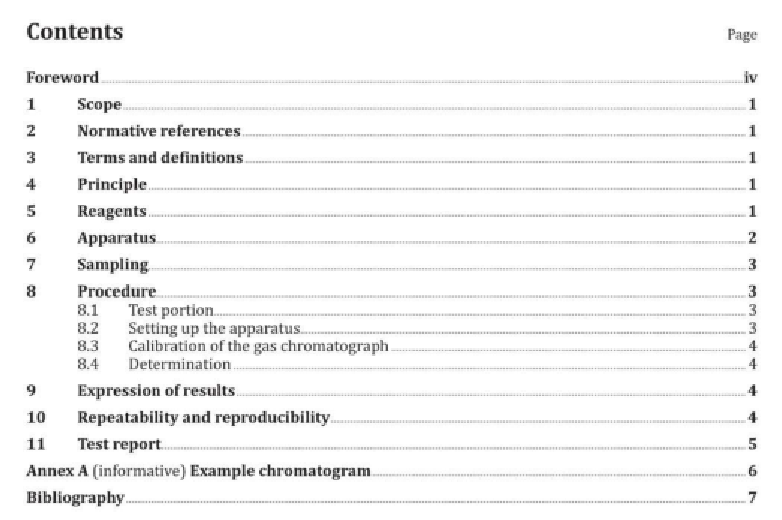ISO 20714 pdf download

ISO 20714 pdf download E-liquid – Determination of nicotine, propylene glycol and in used in electronic nicotine delivery devices – Gas chromatographic method
5.4 Internal standards of high purity: quinaldine [ CAS: 91-63-4 ], 1,3-butanediol (CAS: 107-88-0), n-heptadecane (CAS: 629-78-7), n-octadecane (CAS: 593-45-3). Anethol and other appropriate internal standards may be used after assessment of their purity and determination that the internal standard does not co-elute with other components in the dilution. The peak area of the internal standard on samples should be monitored for consistency. In cases where inconsistencies are found, analysis of a diluted sample without the internal standard should be performed to confirm the absence of a peak in the extract eluting at the same time as the internal standard.
5.5 Dilution solution: isopropanol ( .5…3. ) containing an appropriate concentration of the internal standard 0,2 mg/ml of quinaldine, 1 mg/ml of 1,3-butanediol, 1 mg/ml of n-heptadecane or 1 mg/ml of n-octadecane
5.6 Reference substances 5.6.1 Nicotine (CAS: 54-11-5 ], of known purity not less than 98 %. Nicotine salicylate (CAS: 29790- 52-1 ] of known purity not less than 98 % may also be used. NOTE The purity of the nicotine or nicotine salicylate can be verified using ISO 13276 or by any other validated method. 5.6.2 Propylene glycol [ CAS: grade, minimum purity 99 %. 5.6.3 Glycerol [ CAS : 56-81-5), analytical grade, minimum Store these reference substances at a temperature in accordance with the manufacturer ’ s recommendation.
5.7 Calibration solutions Prepare a series of at least five calibration solutions with concentrations that cover the range of expected levels to be found in the test portion by adding weighed amounts of nicotine [ .5…6…1 ), propylene glycol and glycerol the dilution solution The following linear ranges were used in the collaborative study: 0,005 mg/ml to 1,5 mg/ml for nicotine, 0,12 mg/ml to 10 mg/ml for propylene glycol and glycerol. Store these solutions between and in a dark environment. Solutions stored at low temperatures shall be allowed to equilibrate to room temperature before use.
6 Apparatus Usual l aboratory apparatus and, in particula r, the following items.
6.1 Gas chromatograph, equipped with a flame ionization detector, recorder, integrator or data handling system.
6.2 Capillary column DB-ALC11l capillary column [ 30 m length × 0,32 mm ID, 1,8 µm film thickness) has been found to be satisfactory. Alternative capillary columns (such as a WAX column) may be used provided that the peaks for solvent, internal standards, nicotine, propylene glycol, glycerol and other e-liquids components are well resolved which can require optimization of the instrument conditions.
7 Sampling
Carry out sampling according to a suitable procedure.
8 Procedure
8.1 Test portion
Allow sample to equilibrate to room temperature before opening.
Weigh, to the nearest 0,001 g, 0,1 g of the sample into the dilution vessel.
Pipette 10 ml of dilution solution the dilution vessel, immediately seal the vessel and mix well. Tr ansfer the solution into a gas chromatography vial and cap the vial. Analysis should be performed as soon as possible, but if storage is inevitable then store the sample at between and in a dark environment until gas chromatography analysis.
8.2 Setting up the apparatus Set up the apparatus and operate the gas accordance with the manufacturer ’ s instructions. Ensure that the peaks for isopropanol, interna l propylene glycol, glycerol, and other e -li quid component peaks are well resolved.
Example of suitable operating conditions for gas chromatography with DB-ALCl are as follows.
Oven temperature profile:
Initial temperature:
Initial hold time: 1 min;
Temperature ramp A: 15 °C/min;
Final temperature A:
Temperature ramp B:
Final temperature B:
Final hold time B: 10 min;
Injection temperature :
Detector temperature:
Injection volume: 1 µl;
Injection mode: split ;
Split ratio: 50:1;
Carrier gas: helium, at a flow rate of 1,8 ml/min;
Air: at a flow rate of 450 ml/min;
Hydrogen: at a flow rate of 40 ml/min .
Optimize the gas chromatography conditions for analytes separation and sensitivity. Once optimized,the same gas chromatography conditions shall be used for the ana lysis of all standards and samples.
NOTE Change of the temperature ramp from to improves peak separation. Use of DB-Wax as an alternative column also improves peak separation.









